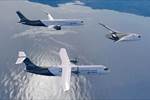Second Beta eCTOL to join Norway international aircraft test arena
The U.S. aircraft will be headed to Europe later in 2025 to, among other things, participate in Bristow, Avinor and the CAA’s plans that will set the foundation for scaling zero- and low-emission aviation.
The Alia CX300. Source | Beta Technologies
In April 2024, Avinor (Oslo, Norway) and the Civil Aviation Authority (CAA) entered a collaboration to establish Norway as an international test arena for zero- and low-emission aviation. On March 4, 2025, the first formal agreement for demonstration flights was signed at Bergen Airport, Flesland, with U.S. aircraft manufacturer Beta Technologies ((South Burlington, Vt.) and Bristow Norway AS (Sola), a subsidiary of Bristow Group Inc.
The demonstration flights will be cargo flights without passengers, conducted using Beta’s Alia CX300 conventional takeoff and landing (eCTOL) aircraft, which will be flown by Bristow Norway. The cargo flights will operate initially between Stavanger Airport and Bergen Airport, starting from Stavanger in late summer, with the entire route commencing later in the fall.
Beta itself recently completed the production build of the Alia aircraft that will perform these demonstrations. The aircraft, the company’s second production-intent vehicle, was manufactured at Beta’s scaled production factory in Burlington, Vermont, and has already received airworthiness certification for VFR, IFR, day and night flying from the Federal Aviation Administration (FAA). It will arrive in Norway later in 2025.
“The government’s goal in the National Aviation Strategy and the National Transport Plan 2025–2036 [NTP] is to accelerate the transition to zero- and low-emission aviation,” says Minister of Transport Jon-Ivar Nygård. “With an aviation industry committed to reducing emissions, a decentralized network of airports of various sizes, a significant regional air transport market, a proactive aviation authority and a supplier industry specializing in battery-electric propulsion systems and hydrogen technology, we have a strong foundation for the early adoption of new technologies.”
The goal of the test arena is to gain knowledge, learning and to prepare the ecosystem and set the foundation for scaling. This means involving airlines, manufacturers, supplier industries, the energy sector and other stakeholders.
“Avinor’s role is to facilitate the infrastructure at airports and make the airspace available for actors who wish to test various zero- and low-emission aircraft in an operational environment,” says Karianne Helland Strand, executive VP for sustainability, concept and infrastructure development at Avinor. “We seek more knowledge about what different technologies and aircraft require in terms of airport facilities and necessary energy supply needs. For example, we currently have a procurement process underway for fast chargers for electric aircraft in Bergen and Stavanger to accommodate the first test flight.
"Aviation is a safe mode of transport and a well-regulated sector,” Helland Strand continues. “As the aviation authority, we will ensure that new technologies can be tested in accordance with regulations. We will learn how regulations and frameworks need to evolve to enable new technologies and concepts. Through this, we will build the necessary expertise early on for the solutions of tomorrow.”
Related Content
-
Braided thermoplastic composite H2 tanks with co-consolidated molded boss areas to fit EV battery space
BRYSON project demonstrates possible designs, automated manufacturing and low permeability concepts, including EVOH liner and novel PPA matrix.
-
Aerospace prepregs with braided reinforcement demonstrate improved production rates, cost
A recent time study compares the layup of a wing spar using prepreg with A&P’s TX-45 continuous braided reinforcement versus traditional twill woven prepreg.
-
Lilium launches M&A process, targets eVTOL program continuation
Despite court-approved insolvency filings and beginning first investor briefings, Lilium remains fully focused on re-emerging following restructuring, setting its sights on fresh investment to support the Lilium Jet.







